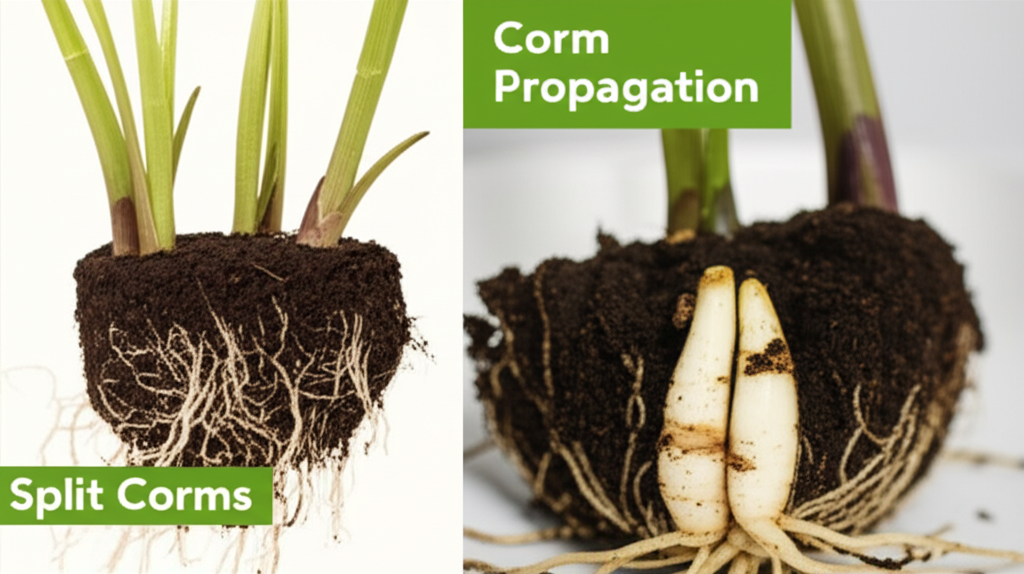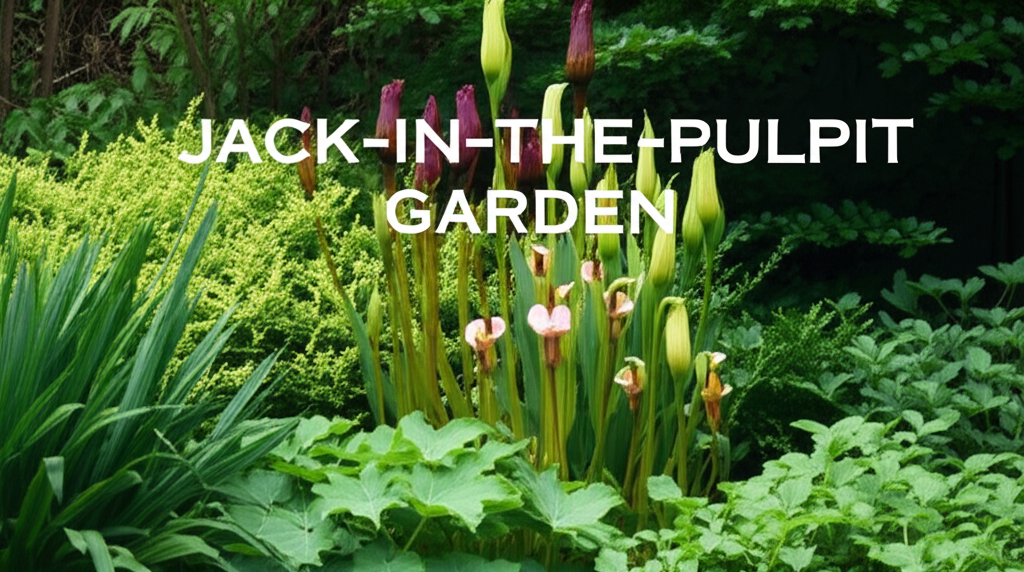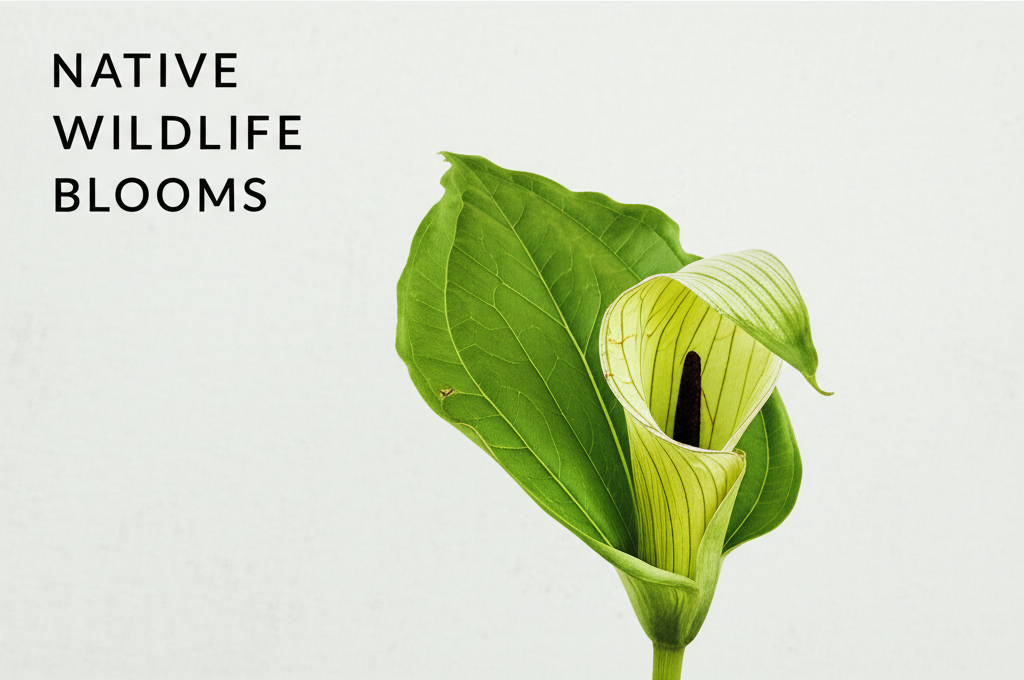Unveiling the Secrets of Jack-in-the-Pulpit Propagation
The Jack-in-the-Pulpit, with its distinctive hooded spathe and bright red berries, is a captivating native woodland plant that adds an element of intrigue to any shade garden. Known scientifically as Arisaema triphyllum, this perennial is not only beautiful but also surprisingly easy to propagate once you understand its life cycle and the simple techniques involved. Among the most effective methods for increasing your Jack-in-the-Pulpit population is through the propagation of its underground storage organs, called corms. This comprehensive guide will walk you through the process of splitting and replanting these corms, ensuring a bountiful harvest of these fascinating plants for your garden or to share with fellow enthusiasts.
Understanding the Jack-in-the-Pulpit Corm

Before diving into the propagation process, it’s crucial to understand what a corm is and how it relates to the Jack-in-the-Pulpit. A corm is a swollen, underground plant stem that serves as a storage organ for food, allowing the plant to survive unfavorable conditions, such as winter dormancy or summer drought. Jack-in-the-Pulpit corms are typically bulbous, with a flattened top and bottom, and are covered in layers of protective tunics.
Over time, a mature Jack-in-the-Pulpit corm will develop smaller offsets, or “bulblets,” around its base. These offsets are essentially miniature versions of the parent corm and contain the genetic material to grow into new, independent plants. The process of propagation through corm splitting leverages this natural reproductive capability.
When to Propagate: Timing is Everything
The optimal time for propagating Jack-in-the-Pulpit corms is during the plant’s dormant period. This typically occurs in late fall after the foliage has yellowed and died back, or in early spring before new growth emerges.
- Late Fall: This is often the preferred time as the corms have had the entire growing season to accumulate energy and develop offsets. The soil is also generally cooler and moister, which can aid in the establishment of newly planted corms.
- Early Spring: If you miss the fall window, early spring is a viable alternative. However, be cautious not to disturb the soil too early, as premature disturbance can damage emerging shoots. Wait until the ground is workable but before significant top growth appears.
The Corm Splitting Process: A Step-by-Step Guide
Propagating Jack-in-the-Pulpit from split corms is a rewarding process that requires a few basic tools and careful handling.
Tools and Materials
- A sharp, clean knife or trowel
- Gardening gloves
- A small brush or cloth for cleaning corms
- A shallow tray or newspaper for laying out corms
- Optional: Cinnamon powder (for antifungal properties)
Step-by-Step Corm Division
- Excavate the Corms: Gently dig up the mature Jack-in-the-Pulpit plants using a trowel or spade, being careful not to damage the corms. Work at a safe distance from the plant’s base to avoid cutting into the corms themselves. Lift the entire clump carefully from the soil.
- Clean the Corms: Gently brush off excess soil from the corms. You can rinse them lightly with water if they are heavily soiled, but ensure they are allowed to air dry slightly afterward to prevent mold.
- Identify and Separate Offsets: Examine the parent corm. You will notice smaller bulbous growths (offsets or bulblets) attached to its sides or base. These are the potential new plants.
- The Split: Using your clean, sharp knife, carefully cut the offsets away from the parent corm. Ensure that each offset has at least one growth bud (the small, pointed tip where the new shoot will emerge) and a portion of the corm’s tissue. If the offsets are large enough, they may already be independent. If they are very small, you can try to gently break them away with your fingers, ensuring they have a bud.
- Treat the Wounds (Optional): Some gardeners advocate for dusting the cut surfaces of the corms with cinnamon powder. Cinnamon has natural antifungal properties and can help prevent rot in the wounded areas.
- Prepare for Planting: Allow the separated corms to air dry in a cool, dry, and shaded location for a few hours to a day. This allows the cut surfaces to callous over, further reducing the risk of rot.
- Replant or Store: Depending on your timing and desired outcome, you can either replant the divided corms immediately or store them for later planting.
Key Facts and Comparison of Propagation Methods
While corm splitting is an excellent method, it’s useful to understand how it compares to other propagation techniques for Jack-in-the-Pulpit.
| Method | Pros | Cons | Maturity Time | Ease of Success |
|---|---|---|---|---|
| Corm Splitting | Relatively fast way to increase plant numbers; utilizes existing mature plants; high success rate with proper technique. | Requires careful handling to avoid damaging buds; best done during dormancy; may temporarily stress the parent plant. | 2-4 years to flowering size from a good-sized offset. | High |
| Seed Propagation | Generates a large number of plants; can be done with fresh seeds. | Very slow process; seeds require specific stratification (cold, moist treatment); germination can be erratic; may take 5-7 years or more to reach flowering size. | 5-7+ years to flowering size. | Low to Moderate |
| Division of Clumps (Natural Offsets) | Similar to corm splitting but often involves separating naturally formed, larger offsets; less invasive to the parent plant if done carefully. | May not yield as many new plants as intentional splitting; requires careful separation to ensure each division has adequate roots/buds. | 2-4 years to flowering size. | High |
Planting Your Divided Corms
Once your corms are ready, it’s time to get them into the ground. The planting location and depth are critical for successful establishment.
Planting Site Selection
Jack-in-the-Pulpits are woodland natives and thrive in conditions that mimic their natural habitat.
- Shade: They prefer dappled shade to full shade. Morning sun with afternoon shade is ideal. Avoid direct, intense sunlight, which can scorch their leaves.
- Soil: Rich, moist, well-draining soil is essential. Amend heavy clay soils with compost or organic matter to improve drainage and fertility. A slightly acidic to neutral pH is generally preferred.
- Moisture: While they prefer consistent moisture, they do not like to be waterlogged. Ensure the planting area has good drainage to prevent corm rot.
Planting Depth and Spacing
- Depth: Plant the corms with the growth bud facing upwards, approximately 3-4 inches (7.5-10 cm) below the soil surface.
- Spacing: Space the corms about 6-12 inches (15-30 cm) apart, depending on the expected mature size of the variety.
Caring for Newly Planted Corms
Newly divided and replanted corms require attentive care to ensure they establish successfully.
- Watering: Water thoroughly after planting. Keep the soil consistently moist but not soggy during the initial establishment period. As the plants mature, they will become more tolerant of drier conditions, but consistent moisture is always beneficial.
- Mulching: Apply a layer of organic mulch, such as shredded bark, compost, or leaf mold, around the base of the plants. Mulch helps retain soil moisture, suppress weeds, and regulate soil temperature, creating a more favorable environment for the developing corms.
- Fertilization: Jack-in-the-Pulpits generally do not require heavy fertilization. A light application of compost or a balanced, slow-release organic fertilizer in the spring can be beneficial, but avoid over-fertilizing, which can lead to weak growth and increase susceptibility to diseases.
- Patience: Remember that Jack-in-the-Pulpit corms, especially if they are smaller offsets, may take a year or two to establish a strong root system and begin producing flowering-size plants. Be patient and monitor their progress.
Storage of Corms for Later Planting
If you plan to propagate your Jack-in-the-Pulpits during the dormant season but want to plant them in spring, or if you have an abundance of corms to overwinter, proper storage is key.
Ideal Storage Conditions
- Container: Store the corms in a breathable container, such as a mesh bag, paper bag, or a shallow tray lined with peat moss or vermiculite. Avoid plastic bags, which can trap moisture and promote rot.
- Temperature: Store the corms in a cool, dry, and dark place. An unheated garage, basement, or a cool pantry with temperatures between 40-50°F (4-10°C) is ideal.
- Humidity: Maintain moderate humidity. If the storage area is too dry, the corms may shrivel. If it’s too humid, they can develop mold.
- Monitoring: Periodically check the stored corms for signs of rot or excessive drying. If they appear dry, lightly mist them with water or add a bit of damp peat moss. If you see any signs of rot, remove the affected corms immediately to prevent spread.
Troubleshooting Common Issues
While propagation via corm splitting is generally successful, a few common issues can arise.
Rot
The most frequent problem encountered is corm rot, usually caused by overwatering, poor drainage, or fungal infections.
- Prevention: Ensure good drainage, avoid overwatering, and use cinnamon powder on cut surfaces. Store corms in breathable containers.
- Treatment: If rot is detected, remove the affected parts of the corm immediately. If the rot is extensive, it may be best to discard the corm to prevent it from spreading to healthy ones.
Lack of Growth
Sometimes, planted corms may not show significant growth in the first year.
- Causes: This can be due to the corm being too small, insufficient light, poor soil conditions, or a damaged growth bud.
- Solution: Ensure optimal planting conditions and be patient. Smaller corms may need an extra year to establish before they produce visible top growth.
Pests
While not a major problem, slugs and snails can sometimes damage young Jack-in-the-Pulpit foliage.
- Control: Use slug bait, beer traps, or handpick them in the early morning or evening.
Pros and Cons of Corm Splitting
To summarize the advantages and disadvantages of this propagation method, consider the following:
| Pros | Cons |
|---|---|
| Increases Plant Numbers: An efficient way to multiply your collection of Jack-in-the-Pulpits. | Risk of Rot: Cut surfaces are susceptible to rot if not handled properly or if stored/planted in overly wet conditions. |
| Faster Than Seed: Results in mature plants much sooner than growing from seed. | Requires Dormancy: Best performed during the plant’s dormant period, limiting propagation to specific times of the year. |
| Utilizes Existing Plants: Allows you to divide established, healthy plants without harming them significantly. | Potential for Damage: Care must be taken when splitting to avoid damaging the vital growth buds on the corms. |
| High Success Rate: With proper technique and care, the success rate is very high. | Temporary Stress: The parent plant may experience some temporary stress after division. |
| Preserves Genetics: Ensures that the new plants are genetically identical to the parent plant. | Limited Availability: You need to have at least one mature Jack-in-the-Pulpit to start the process. |
Conclusion: A Rewarding Endeavor
Propagating Jack-in-the-Pulpit from split corms is a straightforward and highly rewarding gardening practice. By understanding the optimal timing, employing careful techniques for division, and providing the correct planting and care, you can successfully expand your collection of these unique native plants. The patience required for their growth from corm offsets is amply repaid by the visual spectacle and ecological benefits they bring to any woodland or shade garden. Happy gardening!


